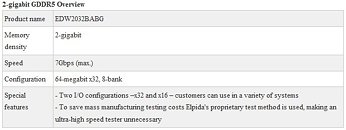- Joined
- Oct 9, 2007
- Messages
- 47,300 (7.52/day)
- Location
- Hyderabad, India
| System Name | RBMK-1000 |
|---|---|
| Processor | AMD Ryzen 7 5700G |
| Motherboard | ASUS ROG Strix B450-E Gaming |
| Cooling | DeepCool Gammax L240 V2 |
| Memory | 2x 8GB G.Skill Sniper X |
| Video Card(s) | Palit GeForce RTX 2080 SUPER GameRock |
| Storage | Western Digital Black NVMe 512GB |
| Display(s) | BenQ 1440p 60 Hz 27-inch |
| Case | Corsair Carbide 100R |
| Audio Device(s) | ASUS SupremeFX S1220A |
| Power Supply | Cooler Master MWE Gold 650W |
| Mouse | ASUS ROG Strix Impact |
| Keyboard | Gamdias Hermes E2 |
| Software | Windows 11 Pro |
Elpida Memory, Inc., Japan's leading global supplier of Dynamic Random Access Memory (DRAM), today announced that it had completed development of a high-density, high-speed, low-power consumption 50nm process 2-gigabit GDDR5 using copper interconnects (product name: EDW2032BABG). The new GDDR5, the first graphics DRAM designed by Elpida, was developed at the company's Munich Design Center in Germany.
Applications for GDDR (GDDR: Graphics Double Data Rate) memory devices used with GPU (Graphics Processing Unit) are found not only in such graphic processing equipment as game consoles and PC graphics cards but also in equipment that require high-performance computing for use in such areas as science and technology, physical simulation, digital image processing and video conversion. Using 2-gigabit GDDR5 in these applications can double the frame buffer size of each GPU compared with 1-gigabit memory products.

As a result, the GPU can perform high-speed processing without exchanging large-volume image data with the main memory, making possible realistic PC graphics images. Also, use of 2-gigabit GDDR5 in such fields as science & technology computing and physical simulations is expected to improve system performance, as systems installed with the new graphics DRAM can handle larger amounts of data and more thread processing.
At present, Elpida is outsourcing 1-gigabit GDDR3/GDDR5 production to Taiwan-based Winbond Electronics Corporation. The company's Hiroshima Plant, however, plans to handle 2-gigabit GDDR5 production. Basing this production in Hiroshima enables Elpida to provide a more timely and flexible response to anticipated future growth in graphics DRAM demand.
Elpida plans to begin sample shipments of the new 2-gigabit GDDR5 in July 2010. Mass production is expected to get underway in the CY 2010 third quarter (July-Sept).

View at TechPowerUp Main Site
Applications for GDDR (GDDR: Graphics Double Data Rate) memory devices used with GPU (Graphics Processing Unit) are found not only in such graphic processing equipment as game consoles and PC graphics cards but also in equipment that require high-performance computing for use in such areas as science and technology, physical simulation, digital image processing and video conversion. Using 2-gigabit GDDR5 in these applications can double the frame buffer size of each GPU compared with 1-gigabit memory products.

As a result, the GPU can perform high-speed processing without exchanging large-volume image data with the main memory, making possible realistic PC graphics images. Also, use of 2-gigabit GDDR5 in such fields as science & technology computing and physical simulations is expected to improve system performance, as systems installed with the new graphics DRAM can handle larger amounts of data and more thread processing.
At present, Elpida is outsourcing 1-gigabit GDDR3/GDDR5 production to Taiwan-based Winbond Electronics Corporation. The company's Hiroshima Plant, however, plans to handle 2-gigabit GDDR5 production. Basing this production in Hiroshima enables Elpida to provide a more timely and flexible response to anticipated future growth in graphics DRAM demand.
Elpida plans to begin sample shipments of the new 2-gigabit GDDR5 in July 2010. Mass production is expected to get underway in the CY 2010 third quarter (July-Sept).

View at TechPowerUp Main Site




